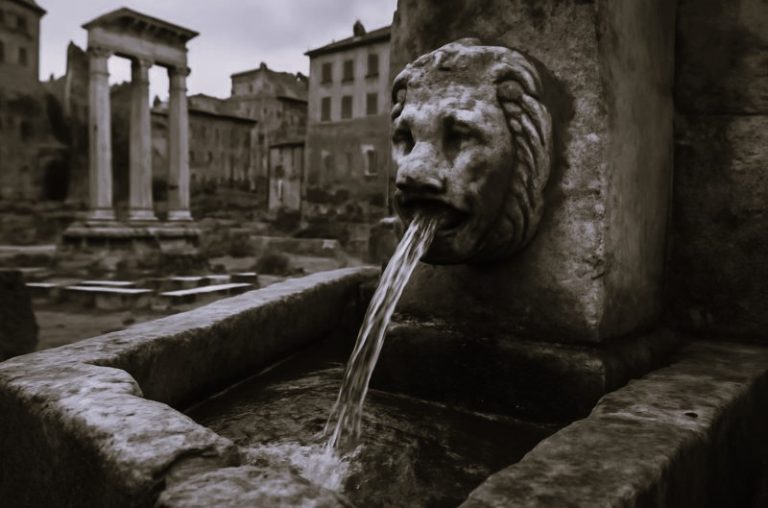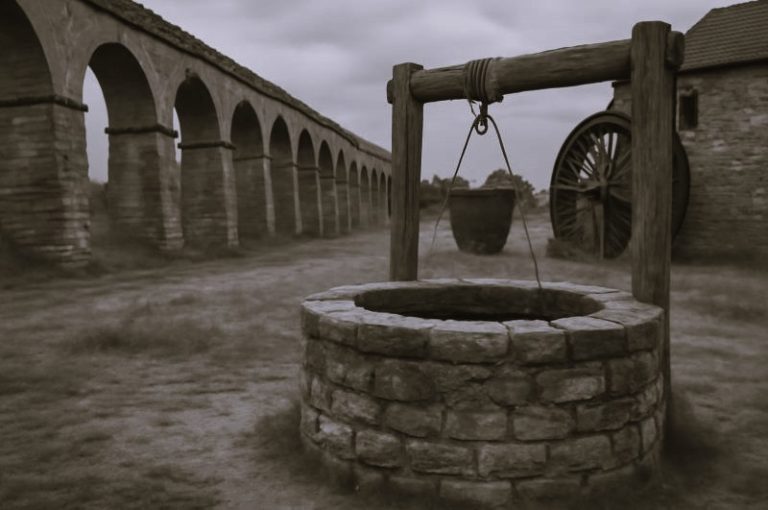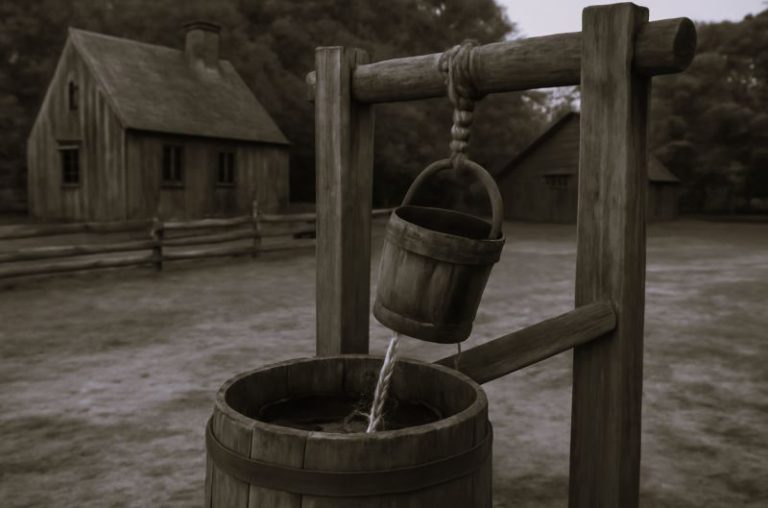
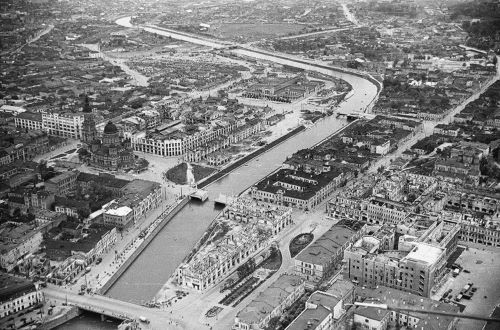
Kharkiv was founded in 1654 as Kharkiv Fortress and grew to be a center of industry and trade.
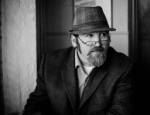
Curated/Reviewed by Matthew A. McIntosh
Public Historian
Brewminate
Introduction
Kharkiv is the second-largest city and municipality in Ukraine.[6] Located in the northeast of the country, it is the largest city of the historic Slobozhanshchyna region. Kharkiv is the administrative centre of Kharkiv Oblast and of the surrounding Kharkiv Raion. The latest population is 1,433,886 (2021 est.).[7] The city is currently in a state of war against the Russian Federation.
Kharkiv was founded in 1654 as Kharkiv fortress, and after these humble beginnings, it grew to be a major centre of industry, trade and Ukrainian culture in the Russian Empire. At the beginning of the 20th century, the city was predominantly Russian in population, but after the Soviet government’s policy of Ukrainization the city became populated mainly by Ukrainians with a significant number of Russians.[8][9] Kharkiv was the first capital of the Ukrainian Soviet Socialist Republic, from December 1919 to January 1934, after which the capital relocated to Kyiv.[10]
Presently, Kharkiv is a major cultural, scientific, educational, transport and industrial centre of Ukraine, with numerous museums, theatres and libraries, including the Annunciation and Dormition Cathedrals, the Derzhprom building in Freedom Square, and the National University of Kharkiv. Kharkiv was a host city for UEFA Euro 2012.

Industry plays a significant role in Kharkiv’s economy, specialized primarily in machinery and electronics. There are hundreds of industrial facilities throughout the city, including the Morozov Design Bureau and the Malyshev Tank Factory (leaders in world tank production from the 1930s to the 1980s); Khartron (aerospace, nuclear power plants and automation electronics); Turboatom (turbines for hydro-, thermal- and nuclear-power plants); and Antonov (the multipurpose aircraft manufacturing plant).
Kharkiv was given the title “Hero City of Ukraine” on 6 March 2022.[11]
Early History

Cultural artifacts date back to the Bronze Age, as well as those of later Scythian and Sarmatian settlers. The site was part of the area of the Chernyakhov culture during the 2nd to the 6th centuries. The Khazar fortress of Verkhneye Saltovo (8th to 10th centuries) was about 25 miles east of the site of the modern city, near Staryi Saltiv.[12] During the 12th century, it was part of the territory of the Cumans.
The fortress was founded by re-settlers who were running away from the war that engulfed Right-bank Ukraine in 1654 (see Khmelnytsky Uprising).[1] The years before the region was a sparsely populated part of the Cossack Hetmanate.[13] The group of people came onto the banks of Lopan and Kharkiv rivers where an abandoned settlement stood.[14] According to archive documents, the leader of the re-settlers was otaman Ivan Kryvoshlyk.[1]
The fortress was named for the Kharkiv River. There is a folk etymology that connects the name of both the city and the river to a legendary cossack founder named Kharko[15] or Zechariah.[16] J. B. Rudnyckyj in the 1950s established that the river name is attested earlier than the foundation of the fortress, in the late 16th century.[17]

At first the settlement was self-governed under the jurisdiction of a voivode from Chuhuiv that is 40 kilometres (25 mi) to the east.[14] The first appointed voivode from Moscow was Voyin Selifontov in 1656 who started to build a local ostrog (fort).[14] At that time the population of Kharkiv was just over 1000, half of whom were local cossacks, while Selifontov brought along a Moscow garrison of another 70 servicemen.[14]
The first Kharkiv voivode was replaced in two years after constantly complaining that locals refused to cooperate in building the fort.[14] Kharkiv also became the centre of the local Sloboda cossack regiment as the area surrounding the Belgorod fortress was being heavily militarized. With the resettlement of the area by Ukrainians it came to be known as Sloboda Ukraine, most of which was included under the jurisdiction of the Razryad Prikaz (Military Appointment) headed by a district official from Belgorod. By 1657 the Kharkiv settlement had a fortress[14] with underground passageways.
In 1658 Ivan Ofrosimov was appointed as the new voivode, who worked on forcing locals to kiss the cross to show loyalty to Russian tsar.[14] The locals led by their otaman Ivan Kryvoshlyk refused.[14] However, with the election of the new otaman Tymish Lavrynov the community (hromada) sent a request to the tsar to establish a local Assumption market, signed by deans of Kharkiv churches (the Assumption Cathedral and parish churches of Annunciation and Trinity).[14] Relationships with the neighboring Chuhuiv sometimes were non-friendly and often their arguments were pacified by force.[14] With the appointment of the third voivode Vasiliy Sukhotin was completely finished the construction of the city fort.[14]
Meanwhile, Kharkiv had become the centre of Sloboda Ukraine.[18]
Kharkiv Fortress

The Kharkiv Fortress was erected around the Assumption Cathedral and its castle was at University Hill.[14] It was between today’s streets: vulytsia Kvitky-Osnovianenko, Constitution Square, Rose Luxemburg Square, Proletarian Square, and Cathedral Descent.[14] The fortress had 10 towers: Chuhuivska Tower, Moskovska Tower, Vestovska Tower, Tainytska Tower, Lopanska Corner Tower, Kharkivska Corner Tower and others.[14] The tallest was Vestovska, some 16 metres (52 ft) tall,[14] while the shortest one was Tainytska which had a secret well 35 metres (115 ft) deep.[14] The fortress had the Lopanski Gates.[14]
In 1689 the fortress was expanded to include the Intercession Cathedral and Monastery, which became a seat of a local church hierarch, the Protopope.[14] Coincidentally in the same year in the vicinity of Kharkiv in Kolomak, Ivan Mazepa was announced the Hetman of Ukraine.[14] Kharkiv leading educational institution, the Collegium, was located next to the Intercession Cathedral. It was transferred from Bilhorod to Kharkiv in 1726.[14]
In the Russian Empire
In the course of the administrative reform carried out in 1708 by Peter the Great, the area was included into Kyiv Governorate. Kharkiv is specifically mentioned as one of the towns making a part of the governorate.[19] In 1727, Belgorod Governorate was split off, and Kharkiv moved to Belgorod Governorate. It was the center of a separate administrative unit, Kharkiv Sloboda Cossack regiment. The regiment at some point was detached from Belgorod Governorate, then attached to it again, until in 1765, Sloboda Ukraine Governorate was established with the seat in Kharkiv.[20]
Kharkiv University was established in 1805 in the Palace of Governorate-General.[14] Alexander Mikolajewicz Mickiewicz, brother of Adam Mickiewicz was a professor of law in the university, another celebrity Goethe searched for instructors for the school.[14] In 1906 Ivan Franko received a doctorate in Russian linguistics here.[14][21]
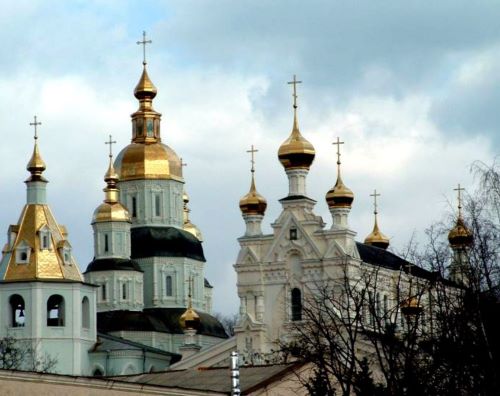
The streets were first cobbled in the city centre in 1830.[22] In 1844 the 90 metres (300 ft) tall Alexander Bell Tower was built next to the first Assumption Cathedral, which on 16 November 1924, was transformed into a radio tower.[14] A system of running water was established in 1870. The Cathedral Descent at one time carried the name of another local trader Vasyl Ivanovych Pashchenko-Tryapkin as Pashchenko Descent.[14] Pashchenko even leased a space to the city council (duma) and was the owner of the city “Old Passage”, the city’s biggest trade center.[14] After his death in 1894 Pashchenko donated all his possessions to the city.[14]
Kharkiv became a major industrial centre and with it a centre of Ukrainian culture. One of the first Prosvitas in Eastern Ukraine was also established in Kharkiv. A powerful nationally aware political movement was also established there and the concept of an Independent Ukraine was first declared there by the lawyer Mykola Mikhnovsky in 1900.
Soon after the Crimean War, in 1860–61 number of hromada societies sprung up across the Ukrainian cities including Kharkiv.[23] Among the most prominent hromada members in Kharkiv was Oleksandr Potebnia, a native of Sloboda Ukraine.[23] Beside the old hromada, in Kharkiv also existed several student hromadas members of which were future political leaders of Ukraine such as Borys Martos, Dmytro Antonovych and many others.[23]
Since April 1780 it was an administrative centre of Kharkov uyezd.
The Red October and the Soviet Period
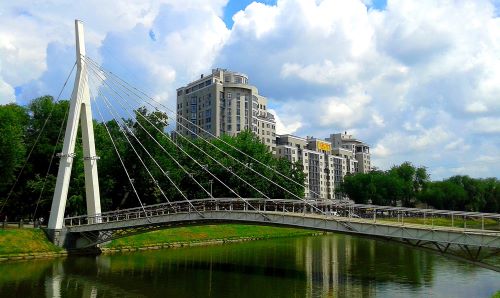
Bolshevik Baltin in the “Chronicle of the Revolution” noted that during the World War I in December 1914 Kharkiv experienced the most eerie Russian chauvinism (see, Great Russian chauvinism) which knew no limits when Russian ultra-nationalist Black Hundreds were assisted by a local police.[24] Baltin also stated that at that time the Kharkiv Locomotive Factory (employing 6,000 workers) was considered a “citadel of revolutionary movement”[24] yet due to pressure of the local police and the Russian nationalists the revolutionary life was completely suppressed.[24]
In January 1915 the Kharkiv Bolshevik organization was accounted of no more than 10 people.[24] The Bolshevik organization in Kharkiv was revived after arrival of Aleksei Medvedev, Nikolay Lyakhin (Petrograd Bolsheviks) and Maksimov and Maria Skobeeva (Moscow Bolsheviks).[24] Following the Russian defeat during Gorlice–Tarnów Offensive and start of the Great Retreat, to Kharkiv from Riga was evacuated a plant of the Public Company of Electricity with 4,000 workers.[24]
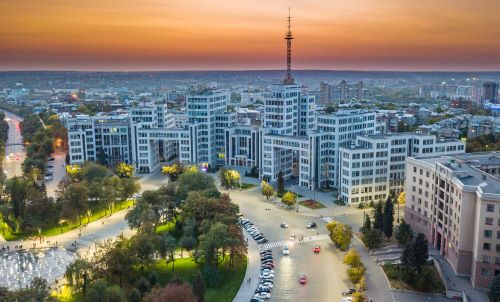
Baltin also pointed that national oppression during the First World War had increased and from it suffered especially Ukrainians.[24] With declaration of the war, there were closed all Ukrainian language newspapers and other periodicals.[24] During the “Great Retreat”, the local pro-Ukrainian socialist-democrats managed to receive permission on publication of Ukrainophone newspaper “Slovo”.[24] It was the first newspaper in Ukrainian language after a year of hiatus.[24] But soon the city administration fined the publisher of the newspaper, after which no other publisher wanted to print the newspaper.[24]
When the Tsentralna Rada announced the establishment of the Ukrainian People’s Republic in November 1917 it envisioned the Sloboda Ukraine Governorate to be part of it.[1] In December 1917 Kharkiv became the first city in Ukraine occupied by the Soviet troops of Vladimir Antonov-Ovseyenko.[25] The Bolsheviks in the Tsentralna Rada moved to Kharkiv shortly after to make it their stronghold and formed their own Rada on 13 December 1917.[25][26] By February 1918 Bolshevik forces had captured much of Ukraine.[27]

In February 1918 Kharkiv became the capital of the Donetsk-Krivoy Rog Soviet Republic; but this entity was disbanded six weeks later.[28] In April 1918 the German army occupied Kharkiv.[29] And according to the February 1918 Treaty of Brest-Litovsk between the Ukrainian People’s Republic and the Central Powers it became part of the Ukrainian People’s Republic.[30] Early January 1919 Bolshevik forces captured Kharkiv.[18] Mid-June 1919 Anton Denikin’s White movement Volunteer Army captured the city.[31] In December 1919 the Bolshevik Red Army recaptured Kharkiv.[32]
Prior to the formation of the Soviet Union, Bolsheviks established Kharkiv as the capital of the Ukrainian Soviet Socialist Republic (from 1919 to 1934) in opposition to the Ukrainian People’s Republic with its capital of Kyiv.[33]

According to linguist George Shevelov, in the early 1920s the share of secondary schools teaching in the Ukrainian language was lower than the share of the Kharkiv Oblasts ethnic Ukrainian population,[34] even though the Soviet Union had ordered that all schools in the Ukrainian SSR should be Ukrainian speaking (as part of its Ukrainization policy).[35]
As the country’s capital, it underwent intense expansion with the construction of buildings to house the newly established Ukrainian Soviet government and administration. Derzhprom was the second tallest building in Europe and the tallest in the Soviet Union at the time with a height of 63 metres (207 ft).[36] In the 1920s, a 150 metres (490 ft) wooden radio tower was built on top of the building. The Roentgen Institute was established in 1931.[37] During the interwar period the city saw the spread of architectural constructivism.[14]
One of the best representatives of it was the already mentioned Derzhprom, the Building of the Red Army, the Ukrainian Polytechnic Institute of Distance Learning (UZPI), the City Council building, with its massive asymmetric tower, the central department store that was opened on the 15th Anniversary of the October Revolution.[14] The same year on 7 November 1932, the building of Noblemen Assembly was transformed into the building of All-Ukrainian Central Executive Committee.[14][38][39]

In 1928, the SVU (Union for the Freedom of Ukraine) process was initiated and court sessions were staged in the Kharkiv Opera (now the Philharmonia) building.
In the early 1930s, the Holodomor famine drove many people off the land into the cities, and to Kharkiv in particular, in search of food. Many people died and were secretly buried in mass graves in the cemeteries surrounding the city.
In 1934 hundreds of Ukrainian writers, intellectuals and cultural workers were arrested and executed in the attempt to eradicate all vestiges of Ukrainian nationalism in Art. The purges continued into 1938. Blind Ukrainian street musicians Kobzars were also gathered in Kharkiv and murdered by the NKVD.[40] In January 1934 the capital of the Ukrainian SSR was moved from Kharkiv to Kyiv.[10]
During April and May 1940 about 3,900 Polish prisoners of Starobelsk camp were executed in the Kharkiv NKVD building, later secretly buried on the grounds of an NKVD pansionat in Pyatykhatky forest (part of the Katyn massacre) on the outskirts of Kharkiv.[41] The site also contains the numerous bodies of Ukrainian cultural workers who were arrested and shot in the 1937–38 Stalinist purges.
German Occupation
During World War II, Kharkiv was the site of several military engagements (see below). The city was captured by Nazi Germany on 24 October 1941.[42][43] There was a disastrous Red Army offensive that failed to capture the city in May 1942.[44][45]
The city was successfully retaken by the Soviets on 16 February 1943. It was captured for a second time by the Germans on 15 March 1943. It was then finally retaken on 23 August 1943.
Seventy percent of the city was destroyed and tens of thousands of the inhabitants were killed.[46] Kharkiv, the third largest city in the Soviet Union, was the most populous city in the Soviet Union captured by the Germans, since in the years preceding World War II, Kyiv was by population the smaller of the two.

The significant Jewish population of Kharkiv (Kharkiv’s Jewish community prided itself with the second largest synagogue in Europe) suffered greatly during the war. Between December 1941 and January 1942, an estimated 15,000 Jews were killed and buried in a mass grave by the Germans in a ravine outside of town named Drobytsky Yar.[47]
During World War II, four battles took place for control of the city:
- First Battle of Kharkov
- Second Battle of Kharkov
- Third Battle of Kharkov
- Fourth Battle of Kharkov
Before the occupation, Kharkiv’s tank industries were evacuated to the Urals with all their equipment, and became the heart of Red Army’s tank programs (particularly, producing the T-34 tank earlier designed in Kharkiv). These enterprises returned to Kharkiv after the war, and continued to produce tanks.
Of the population of 700,000 that Kharkiv had before the start of World War II, 120,000 became Ost-Arbeiter (slave worker) in Germany, 30,000 were executed and 80,000 starved to death during the war.[18]
Post-World War II Soviet Period
In the post-World War II period, many of the destroyed homes and factories were rebuilt. The city was planned to be rebuilt in the style of Stalinist Classicism.[14]
From 1961 to 1975, the Kharkov Highest Artillery School of Engineering existed for the RVSN (Strategic Rocket Forces).[48]
An airport was built in 1954. In 1975, the Kharkiv subway was opened.
Independent Ukraine
Overview

By its territorial expansion on 6 September 2012, the city increased its area from about 310 to 350 square kilometres (120 to 140 sq mi).[49]
A well-known landmark of Kharkiv is the Freedom Square (Ploshcha Svobody formerly known as Dzerzhinsky Square), which is the ninth largest city square in Europe, and the 28th largest square in the world.
There is an underground rapid-transit system (metro) with about 38.7 km (24 mi) of track and 30 stations. The newest underground station, Peremoha, was opened on 19 August 2016.[50] All the underground stations have very distinctive architecture.
Kharkiv was a host city for UEFA Euro 2012, and hosted three group soccer matches at the reconstructed Metalist Stadium.
In 2006 an improvised explosive device exploded near a supermarket.[51]
In 2007, the city’s Vietnamese minority built the largest Buddhist temple in Europe on a 1 hectare plot with a monument to Ho Chi Minh.[52]
Gorky Park was fully renovated in the 2000s, having a big number of modern attractions, a lake with lilies and sport facilities to play tennis, football, beach volleyball, and basketball.
Feldman Park was created in recent years, containing a big collection of animals, horses, etc.
A judge and his family was decapitated in 2012 in the Kharkiv beheadings.[53]
2014 Pro-Russian Unrest

The Euromaidan protests in the winter of 2013–2014 against then president Viktor Yanukovych consisted of daily gatherings of about 200 protestors near the statue of Taras Shevchenko end were predominantly peaceful.[54] Pro-Yanukovych demonstrations, held near the statue of Lenin, were similarly small.[54]
The 2014 pro-Russian unrest in Ukraine affected Kharkiv but to a lesser extent than in neighbouring Donbass, where tensions led to armed conflict.[55] On 2 March 2014, a Russian “tourist” from Moscow replaced the Ukrainian flag with a Russian flag on the Kharkiv regional state administration building.[56] On 6 April 2014 pro-Russian protestors occupied the building and unilaterally declared independence from Ukraine as the “Kharkov People’s Republic”.[54][57]
The uprising was quelled in less than two days due to rapid reaction of the Ukrainian security forces under then Ukrainian Interior Minister Arsen Avakov and Stepan Poltorak the then acting commander of the Ukrainian Internal Forces.[54][58] A special forces unit from Vinnytsia was sent to the city to crush the separatists.[54] Doubts arose about the local origin of the protestors after they initially stormed an opera and ballet theatre believing it was the city hall.[59]
On 13 April, some pro-Russian protesters again made it inside the Kharkiv regional state administration building.[60] Later on 13 April, the building permanently returned to full Ukrainian control.[57][58][60][61][62][63][64] Violent clashes resulted in the severe beating of at least 50 pro-Ukrainian protesters in attacks by pro-Russian protesters.[60][63]
The mayor of the city, Hennadiy Kernes, who supported the Orange Revolution but later joined the Party of Regions, decided to side with the Ukrainian government.[54]
Kharkiv returned to relative calm by 30 April.[65] Relatively peaceful demonstrations continued to be held, with “pro-Russian” rallies gradually diminishing and “pro-Ukrainian unity” demonstrations growing in numbers.[66][67][68] On 28 September, activists dismantled Ukraine’s largest monument to Lenin at a pro-Ukrainian rally in the central square.[69] Polls conducted from September to December 2014 found little support in Kharkiv for joining Russia.[70][71]
From early November until mid-December, Kharkiv was struck by seven non-lethal bomb blasts. Targets of these attacks included a rock pub known for raising money for Ukrainian forces, a hospital for Ukrainian forces, a military recruiting centre, and a National Guard base.[72] According to SBU investigator Vasyliy Vovk, Russian covert forces were behind the attacks, and had intended to destabilize the otherwise calm city of Kharkiv.[73]
On 8 January 2015 five men wearing balaclavas broke into an office of Station Kharkiv, a volunteer group aiding refugees from Donbass.[74] Simultaneously with physical threats the men demanded to hear the political position of Station Kharkiv.[74] After having been given an answer, the men apologized and left.[74]
On Sunday 22 February 2015, an improvised explosive device in 2015 killed four people and wounded nine during a march commemorating the Euromaidan victims.[54] The authorities launched an ‘anti-terrorist operation’.[75] Kharkiv has experienced more non-lethal small bombings since 22 February 2015 targeting army fuel tanks, an unoccupied passenger train and a Ukrainian flag in the city centre.[76]
On 23 September 2015, 200 people in balaclavas and camouflage picketed the house of former governor Mykhailo Dobkin, and then went to Kharkiv town hall, where they tried to force their way through the police cordon. At least one tear gas grenade was used. The rioters asked the mayor, Hennadiy Kernes, to come out.[77][78]
Recent Years
Until 18 July 2020, Kharkiv was incorporated as a city of oblast significance and served as the administrative center of Kharkiv Raion though it did not belong to the raion. In July 2020, as part of the administrative reform of Ukraine, which reduced the number of raions of Kharkiv Oblast to seven, the city of Kharkiv was merged into Kharkiv Raion.[79][80]
A fire in 2021 killed 15 people.[81]
Kharkiv’s Mayor for ten years, Hennadiy Kernes, died on 17 December 2020 in Berlin of COVID-19.[82][83] Ihor Terekhov of Kernes’s party Kernes Bloc — Successful Kharkiv succeeded him in November 2021.[3][4]
Endnotes
- What Makes Kharkiv Ukrainian, The Ukrainian Week (23 November 2014)
- (in Ukrainian) Another 48 streets and 5 districts “decommunized” in Kharkiv, Ukrayinska Pravda (3 February 2015)
(in Russian) Three districts renamed in Kharkiv, SQ (3 February 2015)
(in Ukrainian) It was decided not to rename the Zhovtnevyi and the Frunzenskyi districts in Kharkiv, Korrespondent.net (3 February 2015) - (in Ukrainian) Terekhov officially became the mayor of Kharkiv, Ukrayinska Pravda (11 November 2021)
- (in Ukrainian) Kernes’ bloc nominated Terekhov as a candidate for mayor, Ukrayinska Pravda (6 September 2021)
- Ukraine’s second Winter Olympics: one medal, some good performances Archived 3 October 2020 at the Wayback Machine, The Ukrainian Weekly (1 March 1998)
- Kharkiv “never had eastern-western conflicts”, Euronews (23 October 2014)
- “Чисельність наявного населення України (Actual population of Ukraine)” (PDF) (in Ukrainian). State Statistics Service of Ukraine. Retrieved 11 July 2021.
- Государственный архив Харьковской области. Ф. Р-2982, оп. 2, дело 16, стр. 53–54 State archive of the Kharkiv oblast F. R-2982, op. 2, delo 16. pp. 53–54.
- “Демоскоп Weekly – Приложение. Справочник статистических показателей”. www.demoscope.ru. Retrieved 11 August 2021.
- Liber, George (1992). Soviet Nationality Policy, Urban Growth, and Identity Change in the Ukrainian SSR, 1923–1934. Cambridge University Press.
- Богданьок, Олена (6 March 2022). “Харків, Чернігів, Маріуполь, Херсон, Гостомель і Волноваха тепер міста-герої”. Суспільне | Новини (in Ukrainian). Retrieved 13 March 2022.
- Kevin Alan Brook, The Jews of Khazaria (2006), p. 34.
- Roman Solchanyk (January 2001). Ukraine and Russia: The Post-Soviet Transition. Rowman & Littlefield. p. 6.
- (in Ukrainian) Живий Харків. Нічна екскурсія містом-господарем (Living Kharkiv. Nightly excursion through the host-city) Ukrayinska Pravda. 9 June 2012
- Ivan Katchanovski et al. (eds.), Historical Dictionary of Ukraine (2013), p. 253
- “Сторінка:Котляревський. Енеида на малороссійскій языкъ перелицїованная. 1798.pdf/175 — Вікіджерела”. uk.wikisource.org. Retrieved 18 June 2017.
- Slavs in Canada, vol. 2, Inter-university Committee on Canadian Slavs (1968), p. 255.
- Ukraine: A History 4th Edition by Orest Subtelny, University of Toronto Press, 2009
- Указ об учреждении губерний и о росписании к ним городов, 1708 г., декабря 18 [Decree on the establishment of Provinces and cities assigned to them, December 18, 1708]. constitution.garant.ru (in Russian). Retrieved 31 March 2015.
- История административно-территориального деления воронежского края. 2. Воронежская губерния [History of the Administrative-Territorial Division of the Voronezh Region. 2. Voronezh Province.] (in Russian). Archive service of Voronezh Oblast. Archived from the original on 25 May 2013. Retrieved 10 June 2012.
- У Харкові відкрили меморіальну дошку Івану Франку [A memorial plaque to Ivan Franko was unveiled in Kharkiv] (in Ukrainian). Istpravda.com.ua. 23 August 2011. Retrieved 21 July 2012.
- Харків і харків’яни XIX-го сторіччя [Kharkiv and Kharkiv denizens in 19th century photos] (in Ukrainian). Istpravda.com.ua. 24 January 2011. Retrieved 21 July 2012.
- “Hromadas”. Encyclopedia of Ukraine. Retrieved 14 January 2016.
- Балтин, А. “Харьковская организация Р. С.-Д. Р. П. большевиков во время войны.” // Летопись Революции. – 1923. No.5. С. 3-20
- Historical Dictionary of Ukraine (Historical Dictionaries of Europe) by Ivan Katchanovski, Scarecrow Press (Publication date: 11 July 2013), (page 713)
- Literary Politics in Soviet Ukraine, 1917–1934. Durham and London: Duke University Press.
- World War I: A Student Encyclopedia. ABC-CLIO. p. 1195.
- Ukraine: The Phony War?, The New York Review of Books (27 April 2014)
- Spies and Commissars: The Early Years of the Russian Revolution. PublicAffairs.
- Borderlands into Bordered Lands: Geopolitics of Identity in Post-Soviet Ukraine (Soviet and Post-Soviet Politics and Society, Vol. 98) (Volume 98), Ibidem Verlag, 2010, (page 24)
- The Black Book of Communism: Crimes, Terror, Repression, Harvard University Press, 858 pages, ISBN 0-674-07608-7, page 97
- The A to Z of the Russo-Japanese War. Scarecrow Press Inc. (page 101)
- “Донбас і Україна (з історії революційної боротьби 1917–18 рр.) (Donbas and Ukraine. (From articles and declarations of Mykola Skrypnyk))”. Istpravda.com.ua. Retrieved 21 July 2012.
- Games from the Past: The continuity and change of the identity dynamic in Donbas from a historical perspective , Södertörn University (19 May 2014)
- Language Policy in the Soviet Union by Lenore Grenoble, Springer Science+Business Media, 2003, (page 84)
- “Derzhprom statistics”. Kharkov.ua. Retrieved 21 July 2012.
- Khwaja, Barbara (26 May 2017). “Health Reform in Revolutionary Russia”. Socialist Health Association. Retrieved 26 May 2017.
- “Picture of the building in the Vsesvit magazine”. Istpravda.com.ua. 30 April 2012. Retrieved 21 July 2012.
- “Photos of the newspaper “Proletarian” for 1932-33″. Istpravda.com.ua. Retrieved 21 July 2012.
- Ukrainian minstrels: and the blind shall sing by Natalie Kononenko, M.E. Sharp, page 116
- Fischer, Benjamin B., “The Katyn Controversy: Stalin’s Killing Field“, Studies in Intelligence, Winter 1999–2000, last accessed on 10 December 2005
- “Харків часів “дорослого дитинства” Людмили Гурченко (Kharkiv at times of “matured childhood” of Lyudmila Gurchenko)”. Istpravda.com.ua. Retrieved 21 July 2012.
- “Kharkiv through the eyes of Lyudmila Gurchenko”. Andersval.nl. 31 March 2011. Retrieved 15 July 2012.
- The Red Army committed 765,300 men to this offensive, suffering 277,190 casualties (170,958 killed/missing/PoW, 106,232 wounded) and losing 652 tanks, and 4,924 guns and mortars. Glantz, David M., Kharkov 1942, anatomy of a military disaster through Soviet eyes, pub Ian Allan, 1998, page 218.
- per Robert M. Citino, author of “Death of the Wehrmacht”, and other sources, the Red Army came to within a few miles of Kharkiv on 14 May 1942 by Soviet forces under Marshal Timoshenko before being driven back by German forces under Field Marshal Fedor von Bock, p. 100
- Ukrainian Institute of National Remembrance (2015). Ukraine in World War II. Ukraine: Ukrainian Institute of National Remembrance. p. 26.
- Karpyuk, Gennady (23–29 December 2006), Трагедія, про яку дехто не дуже хотів знати [A tragedy that not everyone wanted to know about], Дзеркало Тижня, vol. 49, no. 628, archived from the original on 9 December 2008, retrieved 16 December 2011
- “High Command Strategic Rocket Forces (GK RVSN)”. Retrieved 1 August 2021.
- “Про зміну і встановлення меж міста Харків, Дергачівського і Харківського районів Харківської області”. Search.ligazakon.ua. 18 September 2012. Retrieved 12 March 2013.
- Kharkiv metro reaches 30 stations Kharkiv metro reaches 30 stations, Railway Gazette International (22 August 2016)
- “Ukraine supermarket blasts injure 14 – unconfirmed reports”. Interfax. 22 April 2006. Archived from the original on 24 September 2006. Retrieved 8 January 2007.
- In↑ «Сегодня»,21 December 2007.
- “Judge, Family Beheaded In Kharkiv”. RadioFreeEurope/RadioLiberty. Retrieved 6 December 2019.
“Beheaded body of Ukraine judge found in apartment”. The Telegraph. Agence France-Presse. 16 December 2012. Archived from the original on 11 January 2022. Retrieved 18 August 2013. - Ukraine Authorities Clear Kharkiv Building, Arrest Scores Of ‘Separatists’, Radio Free Europe (8 April 2014)
How Eastern Ukraine Is Adapting and Surviving: The Case of Kharkiv, Carnegie Europe (12 September 2018) - “Ukraine crisis: Timeline”. BBC News. 13 November 2014. Retrieved 22 March 2015.
- Roth, Andrew (4 March 2014). “From Russia, ‘Tourists’ Stir the Protests”. The New York Times.
“Russian site recruits ‘volunteers’ for Ukraine”. BBC News. 4 March 2014. - “Pro-Russia activists declare establishment of ‘Kharkiv people’s republic'”. Focus Information Agency. 7 April 2014. Retrieved 13 April 2014.
- “Kharkiv settles down, while pro-Russian separatists still hold buildings in Luhansk, Donetsk”. Kyiv Post. 8 April 2014. Retrieved 13 April 2014.
- “Protesters Storm Kharkiv Theater Thinking It Was City Hall”. The Moscow Times. 8 April 2014.
- “Kharkiv city government building infiltrated by pro-Russian protesters”. Kyiv Post. 13 April 2014. Retrieved 13 April 2014.
- “Кернес пообіцяв допомогти звільнити затриманих сепаратистів | Українська правда”. Pravda.com.ua. Retrieved 28 April 2014.
- Kharkiv torn between Europe and Russia, Deutsche Welle (6 March 2014)
- “После нападения антимайдановцев на митинг Евромайдана в Харькове пострадало 50 человек : Новости УНИАН”. Unian.net. 14 April 2014. Retrieved 28 April 2014.
- “Latest from the Special Monitoring Mission in Ukraine”. Organisation for Security and Co-operation in Europe. 14 April 2014. Archived from the original on 16 April 2014. Retrieved 16 April 2014.
- “Latest from the Special Monitoring Mission in Ukraine – based on information received up until 29 April 2014” (Press release). Organization for Security and Co-operation in Europe. 30 April 2014. Retrieved 1 May 2014.
- “Latest from the Special Monitoring Mission in Ukraine based on information received until 23 June 2014” (Press release). Organization for Security and Co-operation in Europe. 24 June 2014. Archived from the original on 22 November 2015. Retrieved 22 August 2014.
- “Latest from the Special Monitoring Mission (SMM) in Ukraine based on information received until 18:00 hrs, 23 July” (Press release). Organization for Security and Co-operation in Europe. 24 July 2014. Retrieved 25 July 2014.
- (in Ukrainian) Two liberty square rally, Status quo (17 August 2014)
- Ukrainian Crowds Topple Lenin Statue (Again). Retrieved 29 September 2014.
- Navalny, Alexei (23 September 2014). Соцопрос ФБК по Харьковской и Одесской областям. Европа, Россия, Новороссия [Survey of Kharkov and Odessa Oblasts] (in Russian). navalny.com. Archived from the original on 23 September 2014.
- Лише 3% українців хочуть приєднання їх області до Росії [Only 3% of Ukrainians want their region to become part of Russia]. Dzerkalo Tyzhnia (in Ukrainian). 3 January 2015.
- Seven recent blasts in Ukraine city stir fear of new Russian menace, Los Angeles Times (11 December 2014)
Mysterious spate of bombings hit Ukraine military hub, Agence France-Presse (10 December 2014) - SBU: Russian special services target Kharkiv, Odesa, situation difficult to control, Ukrainian Independent Information Agency (10 December 2014)
- Міліція з ясовує, хто напав на волонтерську “Станцію Харків” [Police finds out who attacked the volunteer-run “Station Kharkiv”] (in Ukrainian). ukrinform.ua. 9 January 2015. Retrieved 22 March 2015.“Станция Харьков” — первый пункт помощи переселенцам из зоны АТО [“Station Kharkiv” – the first point of assistance for displaced persons from the Donbass zone] (in Russian). 24tv.ua. 25 October 2014. Retrieved 22 March 2015.
- UNIAN Anti-terrorist operation launched in Kharkiv due to fatal blast on Sunday – Turchynov, 22 February 2015.
En.Censor.Net, Anti-terrorist operation started in Kharkiv: four participants on the explosion detained, 22 February 2015.
Novorossia.Today, Turchinov announced start of the ATO in Kharkov. The highest level of terrorist threat had been introduced in the city, 23 February 2015. - Bomb Attacks Increase In Ukraine’s Second-Largest City, Kharkiv, NPR (6 April 2015)
Kharkiv explosion targeting Ukrainian flag classified as ‘terrorist act’, Ukraine Today (7 April 2015)
Explosion In Ukraine’s Kharkiv Targets National Flag Memorial, Radio Free Europe/Radio Liberty (7 April 2015) - Unian, Over 200 men in balaclavas brawl at Kharkiv town hall, clash with police, 23 September 2015, 14:10.
- Korrespondent, Появилось видео столкновений у горсовета Харькова [Video of riot at Kharkov City Council], 23 September 2015 17:40
- “Про утворення та ліквідацію районів. Постанова Верховної Ради України № 807-ІХ”. Голос України (in Ukrainian). 18 July 2020. Retrieved 3 October 2020.
- “Нові райони: карти + склад” (in Ukrainian). Міністерство розвитку громад та територій України. 17 July 2020.
- “At least 15 killed, 11 injured in nursing home fire in Ukraine”. Reuters. 21 January 2021. Retrieved 21 January 2021.
Kennedy, Rachael (21 January 2021). “Nursing home blaze in Ukraine kills at least 15 people”. Euronews. Retrieved 21 January 2021. - Kharkiv mayor Kernes dies, Ukrinform (17 December 2020)
Помер Геннадій Кернес: мер Харкова, який виграв вибори з реанімації, BBC Ukrainian (17 December 2020) (in Ukrainian)
Originally published by Wikipedia, 08.14.2002, under a Creative Commons Attribution-ShareAlike 3.0 Unported license.




